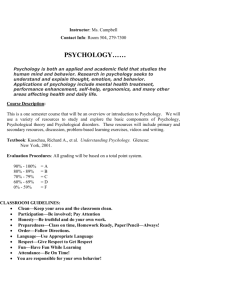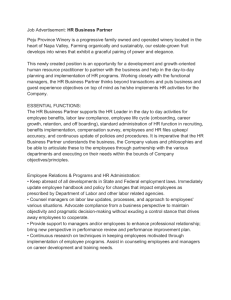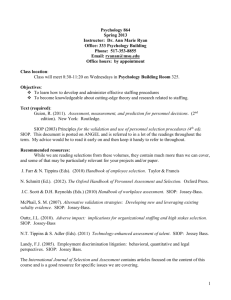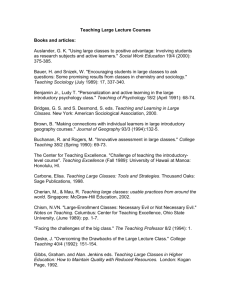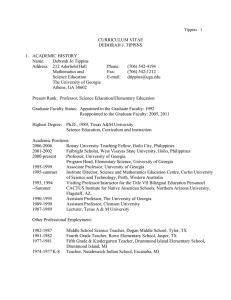Tippins, NT (in press). Technology and
advertisement
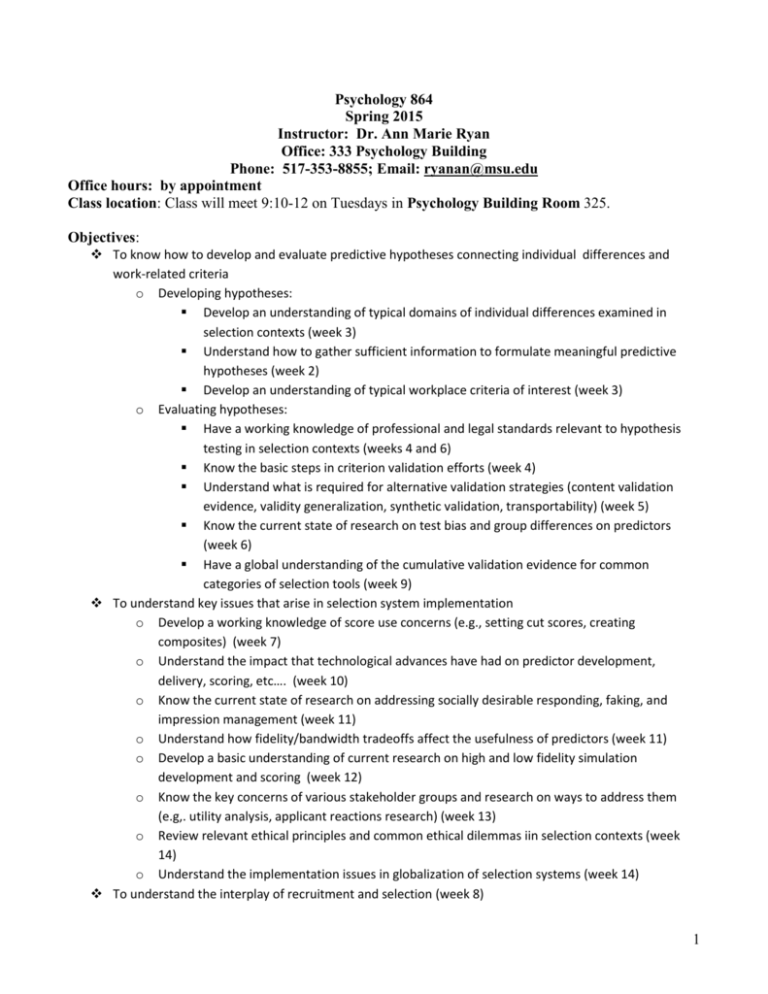
Psychology 864 Spring 2015 Instructor: Dr. Ann Marie Ryan Office: 333 Psychology Building Phone: 517-353-8855; Email: ryanan@msu.edu Office hours: by appointment Class location: Class will meet 9:10-12 on Tuesdays in Psychology Building Room 325. Objectives: To know how to develop and evaluate predictive hypotheses connecting individual differences and work-related criteria o Developing hypotheses: Develop an understanding of typical domains of individual differences examined in selection contexts (week 3) Understand how to gather sufficient information to formulate meaningful predictive hypotheses (week 2) Develop an understanding of typical workplace criteria of interest (week 3) o Evaluating hypotheses: Have a working knowledge of professional and legal standards relevant to hypothesis testing in selection contexts (weeks 4 and 6) Know the basic steps in criterion validation efforts (week 4) Understand what is required for alternative validation strategies (content validation evidence, validity generalization, synthetic validation, transportability) (week 5) Know the current state of research on test bias and group differences on predictors (week 6) Have a global understanding of the cumulative validation evidence for common categories of selection tools (week 9) To understand key issues that arise in selection system implementation o Develop a working knowledge of score use concerns (e.g., setting cut scores, creating composites) (week 7) o Understand the impact that technological advances have had on predictor development, delivery, scoring, etc…. (week 10) o Know the current state of research on addressing socially desirable responding, faking, and impression management (week 11) o Understand how fidelity/bandwidth tradeoffs affect the usefulness of predictors (week 11) o Develop a basic understanding of current research on high and low fidelity simulation development and scoring (week 12) o Know the key concerns of various stakeholder groups and research on ways to address them (e.g,. utility analysis, applicant reactions research) (week 13) o Review relevant ethical principles and common ethical dilemmas iin selection contexts (week 14) o Understand the implementation issues in globalization of selection systems (week 14) To understand the interplay of recruitment and selection (week 8) 1 Text (required): Guion, R. (2011). Assessment, measurement, and prediction for personnel decisions. (2nd edition). New York: Routledge. SIOP (2003) Principles for the validation and use of personnel selection procedures (4th ed). SIOP. This document is posted on D2L and is referred to in a lot of the readings throughout the term. My advice would be to read it early on and then keep it handy to refer to throughout. Recommended resources: J. Farr & N. Tippins (Eds). (2010) Handbook of employee selection. Taylor & Francis N. Schmitt (Ed.). (2012). The Oxford Handbook of Personnel Assessment and Selection. Oxford Press. Website: I rely on D2L to communicate with students regarding the class. All required readings are posted there (for your use only), as well as additional resources of interest. Grades are also posted via D2L as are announcements regarding classes. Grading Criteria: Participation (class attendance, preparation, discussion, article presentation) Validation data analysis Reflection assignments Final exam Applied Project (deliverable and organizational feedback) 60 pts 20 pts 60 pts 100pts 160pts 15% 5% 15% 25% 40% Information on specific assignments can be found under the Assignments folder on D2L. Attendance Policy: For graduate courses, there is a lot of in-class exchange of ideas and discussion of readings. Missing class is problematic and will be considered in awarding of participation points. Absences will be excused only in accordance with ombudsmen’s website on Attendance Policy (see www.msu.edu/unit/ombud) Academic Integrity: Article 2.3.3 of the Academic Freedom Report states that “The student shares with the faculty the responsibility for maintaining the integrity of scholarship, grades, and professional standards.” In addition, the Psychology Department adheres to the policies on academic honesty as specified in General Student Regulations 1.0, Protection of scholarship and grades, the all-University Policy on Integrity of scholarship and Grades, and Ordinance 17.00, Examinations (see MSU website). Therefore, unless specifically directed otherwise, you are expected to complete all course assignments, including homework, papers and exams, without assistance from any source. You are expected to develop original work for this course; therefore, you may not submit course work you completed for 2 another course to satisfy the requirements for this course. Students who violate MSU rules mayl receive a failing grade in this course. Late or missed assignments. Handing in assignments later than the start of class on the date due is not acceptable. Note that the D2L dropbox for assignments automatically stops taking submissions within minutes of the start of class on dates when assignments are due – do NOT wait until the last minute to submit the assignment. Recording As members of a learning community, students are expected to respect the intellectual property of course instructors. All course materials presented to students are subject to the following conditions of use: 1. Students may record lectures/classroom activities and use the recordings for their own courserelated purposes. 2. Students may share the recordings for others enrolled in this specific course section. Sharing is limited to using the recordings only for course-related purposes 3. Students may not post the recordings or any other course materials online or distribute them to anyone not enrolled in this section of the class without the advance written permission of the course instructor and, if applicable, any students whose voice or image is included in the recordings. 4. Any student violating the conditions described above may face academic disciplinary sanctions. Commercialization of lecture notes and university-provided course materials is not permitted in this course. Accommodations If you have a disability that will require accommodations, please see me the first week of class. If you will miss class for a religious observance, let me know in advance. Emergency Procedures If an emergency should occur that would require the cancellation of class, I will send an email via D2L. While an emergency occurring during class is unlikely, please take time the first day to think through your emergency plans for such events (e.g., know at least two exits from the building). Cell phones must be turned off before class starts and put away 3 Readings and Assignments Guion Chapters 5 and 6 are a review of Psych 818. Guion Chapter 13 should also be a review if you have had 818 and 860. You should review these chapters on your own, but feel free to talk with me about any questions you might have about content – basic measurement principles are foundational to selection research, so it is important that you understand these concepts. January 13: Course introduction Guion Ch 1 Bangerter, A., Roulin, N. & Konig, C.J. (2012). Personnel selection as a signaling game. Journal of Applied Psychology, 97, 719-738. RANKING OF SITES DUE JAN 15 9AM January 20: Developing Predictive Hypotheses: Information Gathering Guion Ch 2 Pearlman, K & Sanchez, JI (2010) Work Analysis. In J. Farr & N Tippins (Eds.). Handbook of employee selection. Taylor & Francis. P 73-98. Schippman, J.S. (2010). Competencies, job analysis, and the next generation of modeling. P 197-231. In J.C. Scott & D.H. Reynolds (Eds.) Handbook of workplace assessment. SIOP: Jossey-Bass. Campion, M. A., Fink, A. A., Ruggeberg, B. J., Carr, L., Phillips, G. M., & Odman, R. B. (2011). Doing competencies well: Best practices in competency modeling. Personnel Psychology, 64(1), 225-262. ASSIGNMENT: DISCUSSION BOARD ON ORGANIZATIONAL ASSESSMENT; SET UP FIRST “MEETING” WITH SITE January 27: Developing predictive hypotheses: Predictors and Criteria Variables Guion Ch 3 Borman, W. C & Smith, T. N. (2012). The use of objective measures as criteria in I/O Psychology. In N. Schmitt (Ed.). The Oxford Handbook of Personnel Assessment and Selection. Oxford Press. ASSIGNMENT: JOBS AND CRITERIA REFLECTION 4 February 3: Evaluating Predictive Hypotheses: Validation Basics Guion Ch 7, p 227-256 ONLY Sackett, P.R., Putka, D.J. & McCloy, R.A. (2012). The concept of validity and the process of validation. In N. Schmitt (Ed.). The Oxford Handbook of Personnel Assessment and Selection. Oxford Press. Jeanneret, P.R. & Zedeck, S. (2010). Professional guidelines/standards. In J. Farr & N. Tippins (Eds). Handbook of employee selection. Taylor & Francis. SIOP (2003) Principles for the validation and use of personnel selection procedures (4th ed). SIOP. ASSIGNMENT: OUTLINE FOR DELIVERABLE February 10: Evaluating Predictive Hypotheses: Further issues in validation Guion Ch 7, p256-267; Ch8, p287-292 and p300-304 Gibson, W. M.. & Caplinger, J. A. (2007). Transportation of validation results. In S. M. McPhail (Ed.), Alternative validation strategies: Developing new and leveraging existing validity evidence (pp. 2981). John Wiley. Newman, D. A., Jacobs, R. R., & Bartram, D. (2007). Choosing the best method for local validity estimation: Relative accuracy of meta-analysis versus a local study versus Bayes-analysis. Journal of Applied Psychology, 92, 1394-1413. Johnson, J.W., Steel, P., Scherbaum, C.A., Hoffman, CC, Jeanneret, P.R. & Foster, J. (2010). Validation is like motor oil: synthetic is better. Industrial and Organizational Psychology, 3, 305-328. February 17: Evaluating Predictive Hypotheses: Test bias and group differences Guion Chs 4 and 9 Bobko, P & Roth, PL 2013 Reviewing categorizing and analyzing the literature on black-white mean differences for predictors of job performance: verifying some perceptions and updating/correcting others. Personnel Psychology, 66, 91-126. Landy, F.J., Gutman, A. & Outtz, J.L. (2010). A sampler of legal principles in employment selection. J. Farr & N. Tippins (Eds). (2010) Handbook of employee selection. Taylor & Francis (Ch 29) Outtz, J.L. & Newman, D.A. (2010). A theory of adverse impact. In Outtz, J.L. (Ed). Adverse impact: implications for organizational staffing and high stakes selection. P 53-94. Berry, C.M. (in press). Differential Validity and Differential Prediction of Cognitive Ability Tests: Understanding Test Bias in the Employment Context, Annual Review of Organizational Psychology and Organizational Behavior Vol. 2 (Volume publication date April 2015) 5 February 24: Using selection tools **SPECIAL MEET TIME 8:00-10:45*** Guion Ch 8, 269-286; Ch 11 p394-398 only; Ch 15, p 521-524 only Kehoe, J. (2010). Cut scores and adverse impact. In Outtz, J.L. (Ed). Adverse impact: implications for organizational staffing and high stakes selection. P289-322 Hattrup, K. (2012). Using composite predictors in selection. In N. Schmitt (Ed.). The Oxford Handbook of Personnel Assessment and Selection. Oxford Press. DeCorte, W., Sackett, P.R. & Lievens, F. (2011) Designing pareto-optimal selection systems: formalizing the decisions required for selection system development. JAP, 96, 907-926. Kuncel, N.R., Klieger, DM, Connelly, BS & Ones, DS (2013). Mechanical versus clinical data combination in selection and admissions decisions: a meta-analysis. Journal of Applied Psychology, 98, 1060-1072. ASSIGNMENT: VALIDATION ANALYSIS March 3: Recruitment Ryan, A. M. (2012). Applicant-organization relationship and employee-organization relationship: What is the connection? The employee–organization relationship: Applications for the 21st century. (pp. 363389) Routledge/Taylor & Francis Group, New York, NY. Harold, CM, Uggerslev, KL & Kraichy, D. (2014). Recruitment and job choice. In K.Y.T. Yu & D.M. Cable (Eds.). The Oxford Handbook of Recruitment. Oxford, Oxford University Press p47-72 (Ch 5) Carlson, KD & MechamRL (2014). Research design in evaluating recruitment effectiveness: past, present and future. In K.Y.T. Yu & D.M. Cable (Eds.). The Oxford Handbook of Recruitment. Oxford, Oxford University Press, p184-214. (Ch 12) Swider, B. W., Zimmerman, R. D., & Barrick, M. R. (in press). Searching for the right fit: Development of applicant person-organization fit perceptions during the recruitment process. Journal of Applied Psychology, Scullen, SE & Meyer, BC (2014). More Applicants or More Applications per Applicant? A Big Question When Pools Are Small. Journal of Management, 40, 175-1699. ASSIGNMENT: RECRUITMENT REFLECTION March 10: SPRING BREAK 6 March 17: “Current status” for some common tools Guion Ch 14; Ch 15 p524-534 Levashina, J., Hartwell CJ, Morgeson FP & Campion MA 2014 The structured employment interview: narrative and quantitative review of the research literature Personnel Psychology 67 241-293 Schmitt, N., & Golubovich, J. (2013). Biographical information. APA handbook of testing and assessment in psychology, vol. 1: Test theory and testing and assessment in industrial and organizational psychology. (pp. 437-455) American Psychological Association, Washington, DC. Nye, C. D., Su, R., Rounds, J., & Drasgow, F. (2012). Vocational interests and performance: A quantitative summary of over 60 years of research. Perspectives on Psychological Science, 7(4), 384403. The next 5 papers are a set; read them in order. Van Iddekinge, CH, Roth, PL, Raymark PH & Odle-Dusseau 2012 The criterion-related validity of integrity tests: an updated meta-analysis JAP, 97, 499-531. Harris, WG., Jones JW, Klion, R, Arnold, DW, Camara, W & Cunningham, MR (2012). Test publishers’ perspective on “an updated meta-analysis”: comment on Van Iddekinge, Roth, Raymark & Odle-Dusseau (2012), JAP, 97, 531-53 Ones, D.S., Viswesvaran, C & Schmidt, FL (2012). Integrity tests predict counterproductive work behahviors and job performance well: comment on Van Iddekinge, Roth, Raymark & OdleDusseau (2012), JAP, 97, 537-542 Van Iddekinge, CH, Roth, PL, Raymark PH & Odle-Dusseau 2012. The critical role of the research question, inclusion criteria, and transparency in meta-anlayses of integrity test research: a reply to Harris et al (2012) and Ones, Viswesvaran, and Schmidt (2012), JAP, 97, 543-549 Perspective: Sackett, PR & Schmitt N (2012). On reconciling conflicting meta-analytic findings regarding integrity test validity. JAP 97 550-556. Joseph, D. L., Jin, J., Newman, D. A., & O’Boyle, E. H. (in press). Why does self-reported emotional intelligence predict job performance? A meta-analytic investigation of mixed EI. Journal of Applied Psychology, Morris, S. B., Daisley, R. L., Wheeler, M., & Boyer, P. (in press). A meta-analysis of the relationship between individual assessments and job performance. Journal of Applied Psychology ASSIGNMENT: ASSESSMENT EXPLORATION March 24: Implementation: Technology and special concerns of cognitive predictors Guion Ch 10, p335-353 only; Guion Ch 11 p 385-389 and p 391-394 and p407-408 Tippins, NT (in press). Technology and Assessment in Selection Annual Review of Organizational Psychology and Organizational BehaviorVol. 2 (Volume publication date April 2015) 7 McCloy, RA & Gibby, RE (2011). Computerized adaptive testing. P153-189. In N.T. Tippins & S. Adler (Eds). Technology-enhanced assessment of talent. SIOP: Jossey Bass. Ch 5 Fetzer, M. & Kantrowitz, T. (2011). Implementing computer adaptive tests. P 380-393. In N.T. Tippins & S. Adler (Eds). Technology-enhanced assessment of talent. SIOP: Jossey Bass. Ch 15 Roth, P.L., Bobko, P., van Iddekinge, CH & Thatcher, JB (in press). Social Media in Employee Selection-Related Decisions: A Research Agenda for Uncharted Territory. Journal of Management. Dineen, BR & Allen DG (2014). Internet recruiting 2.0: Shifting paradigms. In K.Y.T. Yu & D.M. Cable (Eds.). The Oxford Handbook of Recruitment. Oxford, Oxford University Press 382-401.Ch21 Wee, S., Newman DA & Joseph, DL 2014. More than g: selection quality and adverse impact implications of considering second-stratum cognitive abilities. JAP 99 547-563. ASSIGNMENT: FIRST DRAFT PRODUCT March 31: Implementation: Social desirability/impression management and special concerns of noncognitive predictors Guion Ch 11, p402-407 only Judge, TA, Rodell, JB, Kliner, RL, Simon, LS & Crawford, ER (2013). Hierarchical representations of the five-factor model of personality in predicting job performance: integrating three organizing frameworks with two theoretical perspectives. Journal of Applied Psychology, 98, 875-925. Carter, NT, Dalal, DK, Boyce, AS, O’Connell, MS, Kung, M & Delgado, KM (2014). Uncovering curvilinear relationships between conscientiousness and job performance: how theoretically appropriate measurement makes an empirical difference. Journal of Applied Psychology, 99, 564-586 Stark, S., Chernyshenko, O. S., Drasgow, F., Nye, C. D., White, L. A., Heffner, T., et al. (2014). From ABLE to TAPAS: A new generation of personality tests to support military selection and classification decisions. Military Psychology, 26(3), 153-164. Roulin, N., Bangerter, A., & Levashina, J. (2014). Honest and deceptive impression management in the employment interview: Can it be detected and how does it impact evaluations? Personnel Psychology, Marr, JC & Cable, DM (2014). Do interviewers sell themselves short? The effects of selling orientation on interviewers’ judgments. Academy of Management Journal, 57, 624-651. April 7: Deeper focus: Low and high fidelity simulations Guion Ch11, 389-391; Ch 15 534-552 8 Lievens, F. & DeSoete B (2012). Simulations. In N. Schmitt (Ed.). The Oxford Handbook of Personnel Assessment and Selection. Oxford Press.383Jansen, A, Melchers KG, Lievens, F, Kleinmann, M, Brandli, M, Fraefel, L, & Konig, CJ 2013. Situation assessment as an ignored factor in the behavioral consistency paradigm underlying the validity of personnel selection procedures. JAP, 98, 326-341. Campion, M. C., Ployhart, R. E., & MacKenzie, W. I., Jr. (2014). The state of research on situational judgment tests: A content analysis and directions for future research. Human Performance, 27(4), 283310. Lievens, F., DeCorte, W. & Westerveld, L. (in press). Understanding the Building Blocks of Selection Procedures: Effects of Response Fidelity on Performance and Validity. Journal of Management. Meriac, JP, Hoffman, BJ, & Woehr, DJ (2014). A Conceptual and Empirical Review of the Structure of Assessment Center Dimensions. Journal of Management, 40, 1269-1296. Each class member will be asked to give a brief summary of a key takeaway from one SJT OR one AC paper from lists below: SJTs: Rockstuhl, T., Ang, S., Ng, K., Lievens, F., & Van Dyne, L. (2014). Putting judging situations into situational judgment tests: Evidence from intercultural multimedia SJTs. Journal of Applied Psychology, Krumm, S., Lievens, F., Hüffmeier, J., Lipnevich, A. A., Bendels, H., & Hertel, G. (2014). How “Situational” is judgment in situational judgment tests? Journal of Applied Psychology Arthur, W., Jr., Glaze, R. M., Jarrett, S. M., White, C. D., Schurig, I., & Taylor, J. E. (2014). Comparative evaluation of three situational judgment test response formats in terms of construct-related validity, subgroup differences, and susceptibility to response distortion. Journal of Applied Psychology, 99(3), 535-545. Slaughter, J. E., Christian, M. S., Podsakoff, N. P., Sinar, E. F., & Lievens, F. (2014). On the limitations of using situational judgment tests to measure interpersonal skills: The moderating influence of employee anger. Personnel Psychology, 67(4), 847-885. ACs: Lievens, F., Schollaert, E., & Keen, G. (2014). The interplay of elicitation and evaluation of traitexpressive behavior: Evidence in assessment center exercises. Journal of Applied Psychology, Schollaert, E., & Lievens, F. (2012). Building situational stimuli in assessment center exercises: Do specific exercise instructions and role-player prompts increase the observability of behavior? Human Performance, 25(3), 255-271. 9 Putka, D. J., & Hoffman, B. J. (2013). Clarifying the contribution of assessee-, dimension-, exercise-, and assessor-related effects to reliable and unreliable variance in assessment center ratings. Journal of Applied Psychology, 98(1), 114-133. Monahan, E. L., Hoffman, B. J., Lance, C. E., Jackson, D. J. R., & Foster, M. R. (2013). Now you see them, now you do not: The influence of indicator–factor ratio on support for assessment center dimensions. Personnel Psychology, 66(4), 1009-1047. Oliver, T., Hausdorf, P., Lievens, F., & Conlon, P. (2014). Interpersonal dynamics in assessment center exercises: Effects of role player portrayed disposition. Journal of Management Kuncel, N. R., & Sackett, P. R. (2014). Resolving the assessment center construct validity problem (as we know it). Journal of Applied Psychology, 99(1), 38-47 Speer, A. B., Christiansen, N. D., Melchers, K. G., König, C. J., & Kleinmann, M. (2014). Establishing the cross-situational convergence of the ability to identify criteria: Consistency and prediction across similar and dissimilar assessment center exercises. Human Performance, 27(1), 44-60. ASSIGNMENT: PREP TO PRESENT ARTICLE April 14: Implementation: Stakeholders Guion Ch 12, 423-425 Kehoe, J, Brown S & Hoffman CC (2012). The life cycle of successful selection programs. In N. Schmitt (Ed.). The Oxford Handbook of Personnel Assessment and Selection. Oxford Press Sturman MC (2012) Employee value: combining utility analysis with strategic human resource management research to yield strong theory. In N. Schmitt (Ed.). The Oxford Handbook of Personnel Assessment and Selection. Oxford Press Boudreau, JW (2012) “Retooling” evidence-based staffing: extending the validation paradigm using management mental models. In N. Schmitt (Ed.). The Oxford Handbook of Personnel Assessment and Selection. Oxford Press Slaughter, JE & Kausel, EE (2014). Employee selection decisions. In S. Highhouse, RS Dalal & E Salas (Eds.). Judgment and decision making at work. New York: Routledge. P 57-79. Gilliland SW & Steiner DD (2012) Applicant reactions to testing and selection In N. Schmitt (Ed.). The Oxford Handbook of Personnel Assessment and Selection. Oxford Press McCarthy, JM, Van Iddekinge CH, Lievens, F, Kung, M, Sinar, EF & Campion MA 2013 Do candidate reactions relate to job performance or affect criterion-related validity? A multistudy investigation of relations among reactions, selection test scores, and job performance JAP 98, 701-719 ASSIGNMENT: ADMINISTRATION REFLECTION 10 April 21: Cases week (NO CLASS MEETING THIS WEEK) Sellman, WS, Born DH Strickland WJ & Ross JJ (2010). Selection and classification in the US Military. In J. Farr & N. Tippins (Eds). (2010) Handbook of employee selection. Taylor & Francis Ch 31 Jacobs, R & Denning DL (2010). Public sector employment In J. Farr & N. Tippins (Eds). (2010) Handbook of employee selection. Taylor & Francis Ch 32 Malamut, A,van Rooy DL, Davis, VA (2011) Bridging the digital divide across a global business: development of a technology-enabled selection system for low-literacy applicants. In N.T. Tippins & S. Adler (Eds). Technology-enhanced assessment of talent. SIOP: Jossey Bass. Grubb AD (2011) Promotional assessment at the FBI: how the search for a high-tech solution led to a high-fidelity low-tech simulation. In N.T. Tippins & S. Adler (Eds). Technology-enhanced assessment of talent. SIOP: Jossey Bass. Hense R & Janovics J (2011) Case study of technology-enhanced assessment centers. In N.T. Tippins & S. Adler (Eds). Technology-enhanced assessment of talent. SIOP: Jossey Bass. Cucina, JM, Busciglio HH, Thomas PH, Callen NF, Walker DD & Schoepfer RJG (2011) Video-based testing at US customs and border protection. In N.T. Tippins & S. Adler (Eds). Technology-enhanced assessment of talent. SIOP: Jossey Bass. ASSIGNMENT: CASES REFLECTION April 28: Globalization/Ethics/Future of staffing Guion Ch 10 p353-358 and 362-368 only Lefkowtiz J & Lowman RL (2010). Ethics of employee selection. In J. Farr & N. Tippins (Eds). (2010) Handbook of employee selection. Taylor & Francis Ryan, AM & Tippins NT (2010). Global applications of assessment. J.C. Scott & D.H. Reynolds (Eds.) (2010) Handbook of workplace assessment. SIOP: Jossey-Bass The Economist, There’s an app for that, Jan 3, 2015. (May add a reading if something “hot” emerges during term) ASSIGNMENT: FINAL REFLECTION May 8: FINAL EXAM, 7:45-9:45 11 Milestones/assignments due Jan 15 Jan 20 Jan 27 Feb 3 Feb 24 March 3 March 17 March 24 March 31-April 10 April 7 April 14 April 21 April 28 Rankings of site choices Question ideas for information gathering Schedule 1st meeting for late this week if possible Jobs and criteria reflection Detailed outline of your deliverable Validation data analysis Recruitment reflection exploration Draft of product Final product Article discussion leader Administration reflection Case reflection Final reflections 12


